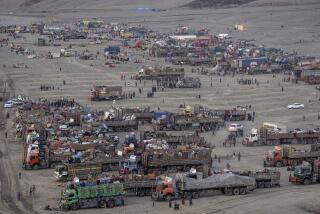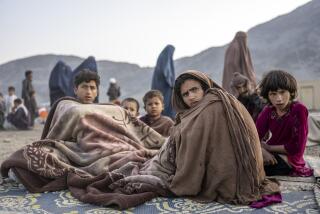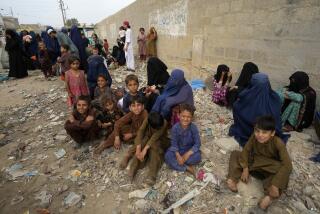U.N. Warns Refugees to Avoid Iran
- Share via
TEHRAN — Afghans fleeing their homeland should think twice about heading for neighboring Iran, a senior U.N. official warned Wednesday after failing to persuade the Islamic Republic to allow refugees into the country on humanitarian grounds.
“The policy of the [Iranian] government is that the borders are closed and that policy will continue,” U.N. High Commissioner for Refugees Ruud Lubbers said after meeting with President Mohammad Khatami and other top Iranian officials. “If you see any possibility to survive [in Afghanistan], don’t come.”
His daylong trip to Iran came after four days of meetings in Pakistan, where Lubbers also failed to persuade leaders to change their closed-door policy on refugees.
Lubbers said he sympathizes with Iran’s concerns about the 2.6 million Afghans already in the country, refugees from warfare stretching back to the Soviet invasion of Afghanistan 22 years ago. Many Iranians resent the influx, which they say has driven up unemployment and strained already scarce resources, including water and electricity.
Lubbers’ meetings here did bear some fruit: Iranian officials agreed to allow future Afghan refugees to congregate in a handful of camps to be set up at the border in Iran, he said.
U.N. and Iranian authorities will probably determine who can stay at those camps, Lubbers said. He also emphasized that unless Iranian police and soldiers guarantee the safety of those areas, the United Nations will not go there.
The international body already forbids its workers to go to the two refugee camps set up a few miles inside Afghanistan between the Iranian city of Zabol and the Afghan city of Zaranj.
“It simply is not safe enough. They are not under the control of the Iranian authorities,” Lubbers said. “It’s a bit rosy to think they are going to stay safe.”
It’s not safe for refugees, either, he added. The thousands of Afghans who are sheltered in those camps could be recruited into the military or forced to work by armed Afghans who control the land, Lubbers said. And Afghan soldiers could use the camps as sources of medicine and food.
Only a small number of nonprofit foreign aid groups are assisting Iranian Red Crescent workers in the two camps, called Mille 46 and Mahkaki. The latter, opened less than two weeks ago in Taliban-held territory, has been overrun with refugees, according to Canadian doctors who are providing help.
At last count, Iranian authorities reported that there were about 6,000 people at Mahkaki, with hundreds sleeping without tents or supplies because of the overwhelming demand. Mille 46, on the other hand, had an estimated 600 people.
Lubbers said he promised Khatami on Wednesday that he will step up fund-raising efforts within the international community to help deal with the refugees heading for Iran, who could number 100,000. The United States, with whom Iran has no diplomatic relations, would not be excluded, Lubbers said.
“I think it’s really needed not to put the bill for this on the table of the government and the people of Iran,” he said.
In Islamabad, the Pakistani capital, U.N. officials described a gradually deteriorating picture of life in Afghanistan amid continued bombing raids and the impending onset of winter.
Stephanie Bunker, the spokeswoman for the office coordinating U.N. activity in Afghanistan, told reporters that relief agencies are especially worried about internally displaced Afghans in the northern part of the country, where the climate is harsher and the population tends to live in more remote areas.
The north is also the part of the country hit hardest by three years of drought and fighting between Taliban and opposition Northern Alliance units--factors that drove some Afghans from their homes before last winter.
*
Times staff writer Tyler Marshall in Islamabad contributed to this report.
More to Read
Sign up for Essential California
The most important California stories and recommendations in your inbox every morning.
You may occasionally receive promotional content from the Los Angeles Times.













